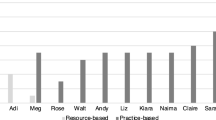Abstract
This paper provides a microanalysis of one Algebra I teacher's instruction to explore the advantages that are afforded us by coordinating two perspectives to document and account for the teacher's mathematical understandings. We use constructs associated with Stein, Grover and Henningsen's domain of mathematical didactics and Realistic Mathematics Education's instructional design theory to infer what the teacher might understand to effectively implement her instructional goals and, more importantly, support student learning. By coordinating these perspectives, we developed a working framework for analyzing the teacher's classroom practice retrospectively. For example, we illustrate how the mathematical possibilities related to one student's question might inform the teacher's decisions as she initiates shifts in students' self-generated models. Additionally, we illustrate how the teacher's decision to capitalize on particular students' models contributes in part to the kinds of mathematical ideas that can be explored and the connections students can make among those ideas. More generally, we explore the utility of coordinating these two perspectives to understand the landscape of ideas that teachers might traverse to align their practices with reform recommendations in the United States.
Similar content being viewed by others
References
Ball, D.L.: 1990, ‘Prospective elementary and secondary teachers, understanding of division,’ Journal for Research in Mathematics Education 21, 132–144.
Ball, D.L., Lubienski, S.T. and Mewborn, D.S.: 2001, ‘Research on teaching mathematics: The unsolved problem of teachers’ mathematical knowledge,’ in V. Richardson (ed.), Handbook of Research on Teaching, 4th ed., Macmillan, New York, pp. 433–456.
Bass, H.: 2005, ‘Mathematics, mathematicians, and mathematics education,’ Bulletin (New Series) of the American Mathematical Society 42(4), 417–430.
Cavey, L.O. and Berenson, S.B.: 2005, ‘Learning to teach high school mathematics: Patterns of growth in understanding right triangle trigonometry during lesson plan study,’ Journal of Mathematical Behavior 24(2), 171–190.
Cobb, P. and Bowers, J.: 1999, ‘Cognitive and situated learning perspectives in theory and practice,’ Educational Researcher 28(2), 4–15.
Cobb, P., Wood, T., Yackel, E. and McNeal, B.: 1992, ‘Characteristics of classroom mathematics traditions: An interactional analysis,’ American Educational Research Journal 29, 573–604.
Freudenthal, H.: 1973, Mathematics as an Educational Task, Reidel, Dordrecht.
Gravemeijer, K.P.E.: 1994, Developing Realistic Mathematics Education, CD-β Press, Utrecht.
Gravemeijer, K.P.E.: 1999, ‘How emergent models may foster the constitution of formal mathematics,’ Mathematical Thinking and Learning 1(2), 155–177.
Greeno, J.G.: 1991, ‘Number sense as situated knowing in a conceptual domain,’ Journal for Research in Mathematics Education 22 (3), 170–218.
Heaton, R.M.: 2000, Teaching Mathematics to the New Standards: Relearning the Dance, Teachers College Press, New York.
Lampert, M.: 1989, ‘Choosing and using mathematical tools in classroom discourse,’ in J. Brophy (ed.), Advances in Research on Teaching, Vol. 1, JAI Press, Greenwich, CT, pp. 223–264.
Simon, M.A.: 1994, ‘Learning mathematics and learning to teach: Learning cycles in mathematics teacher education,’ Educational Studies in Mathematics 26(1), 71–94.
Stein, M.K., Grover, B.W. and Henningsen, M.: 1996, ‘Building student capacity for mathematical thinking and reasoning: An analysis of mathematical tasks used in reform classrooms,’ American Educational Research Journal 33(2), 455–488.
Stephan, M., and Rasmussen, C.: 2002, ‘Classroom mathematical practices in differential equations,’ Journal of Mathematical Behavior 21, 459–490.
Yackel, E.: 2002, ‘The teacher's role in collective argumentation,’ Journal of Mathematical Behavior 21, 423–440.
Whitenack, J.W. and Knipping, N.: 2002, ‘Argumentation, instructional design theory and students’ mathematical learning: A case for coordinating interpretive lenses,’ Journal of Mathematical Behavior 21, 441–457.
Author information
Authors and Affiliations
Corresponding author
Rights and permissions
About this article
Cite this article
Cavey, L.O., Whitenack, J.W. & Lovin, L. Investigating Teachers' Mathematics Teaching Understanding: A Case for Coordinating Perspectives. Educ Stud Math 64, 19–43 (2007). https://doi.org/10.1007/s10649-006-9031-7
Published:
Issue Date:
DOI: https://doi.org/10.1007/s10649-006-9031-7




